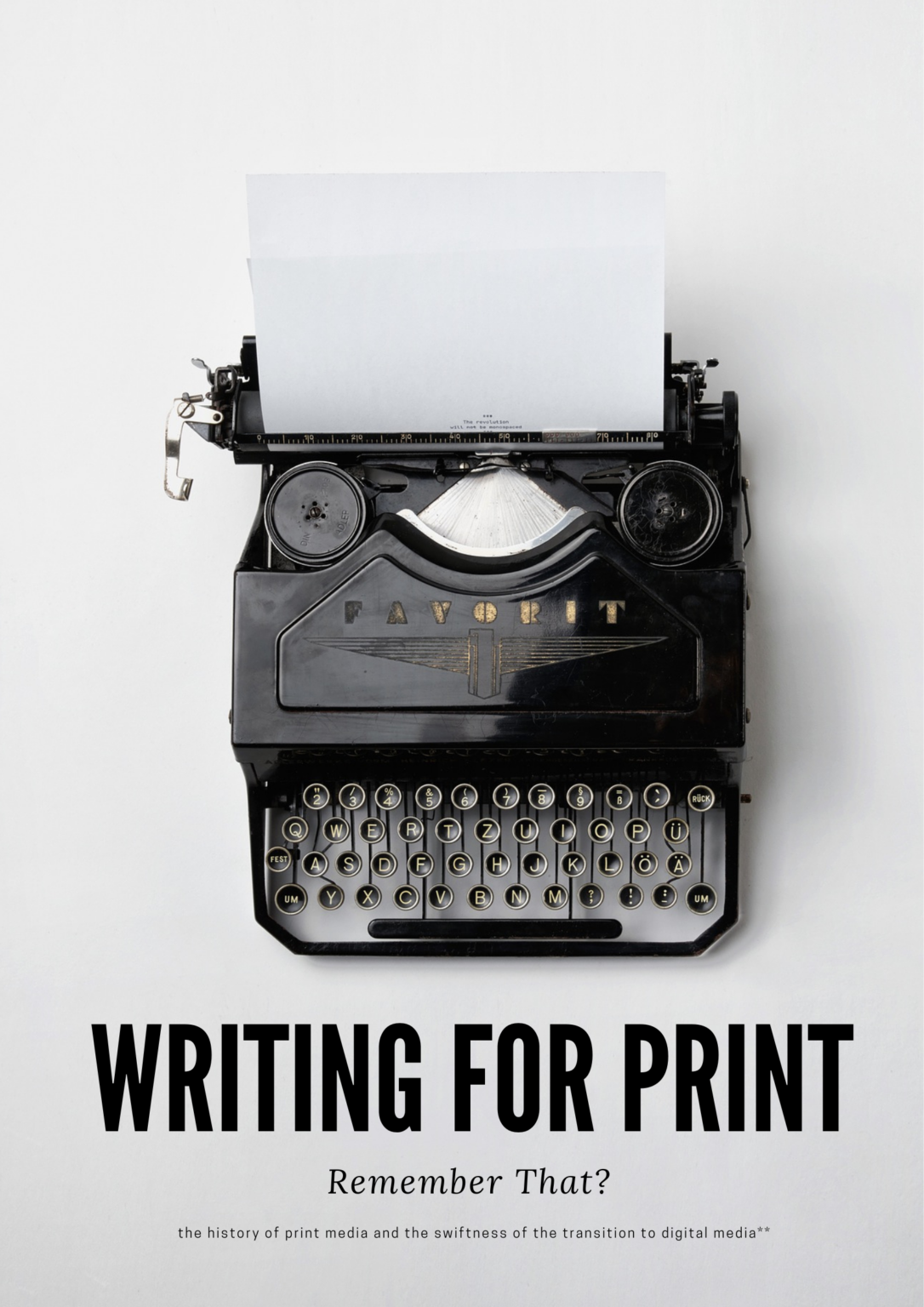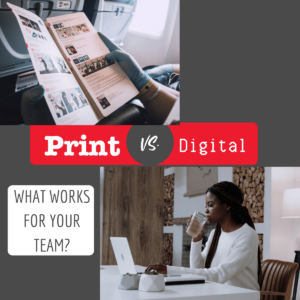People spend hours in front of screens these days, which is far from what life was like in the golden age of print.
The sounds and smells of newspapers and the smooth touch of glossy magazine pages are almost relics of the past. The world moved into the digital age, and so did writing!
I got to thinking about the history of print and the swiftness of the transition to digital media. Although, admittedly, I look back on the print days with some nostalgia, I can see the many ways in which digital media makes marketing communication easier.
Let’s talk about that!
Table of Contents:
-
- The Era of Print Writing
-
- Differences Between Print and Digital Writing
-
- The Shift to Digital Articles
-
- Case Studies and Examples
-
- Challenges and Considerations
-
- The Team to Handle Your Next Writing Project
The Era of Print Writing
Print writing was a breakthrough in mass media communication. All writing that would end up in print had to be well thought-out and planned; then, there was a lengthy editing process before finished pieces could be published.
Although business owners published and could have valuable profiles written about their company, each page had a limited word count.
Articles were revised and rigorously fact-checked because, once printed, there was generally no going back.
When it came to do-overs? Well, that was costly! And retractions and corrections take up precious real estate in a print publication.
As a result, errors and typos could be firing offenses!
In this environment, which was the norm from the 1400s when Johannes Gutenberg invented the printing press to the 1980s when the internet became a thing, the ability to produce consistently high-quality content was a prized achievement for a media outlet (and copy deadlines were absolute, adding to the pressures!)
But here we are in 2024. Technology now evolves at a rapid pace, and print is no longer the primary media used for business communication.
Nowadays, your favorite news stories can be read on a pocket-sized device.
This got us thinking and talking amongst ourselves about the old days—and some of the key differences between print and digital business communication.
Key Differences Between Writing for Print and Digital Writing
-
- Format and Space
The shift from print media to digital media transformed the way content was produced and delivered.
A major difference people saw immediately was the additional space available to write more. Online articles were no longer limited by word count or the physical size of a publication.
With fewer restrictions, writers and business owners could offer more extensive, in-depth information. This new ability in marketing communication, in many ways, made it easier to stand out, educate potential buyers, and reach more potential clients.
-
- Audience Engagement
Audience engagement – which in this context means the capability for two-way communication – is another clear difference between print and digital media.
Print is a one-way communication method whereby intended readers form impressions by going through the printed material without interaction.
On the other hand, readers can often interact with digital writing: they can comment, share, or make contributions in real time (depending on the medium). Reader feedback can also be great for helping writers understand what forms of content their target readers most value and appreciate. Digital data reveals this – or the readers will tell you! Knowing this, communicators can lean into that type of content to create more engagement and leads.
Audience engagement can foster a sense of community and give writers precious opportunities to engage directly with their readers. From a business perspective, you can build a lot of social proof by having a community-like feel to your digital media (whether it’s a blog, case study, or video).
-
- Accessibility and Reach
Print publications are limited to subscribers or the local distribution of paper media, while digital content can reach a global audience, instantly.
Search engines make it easier for readers to find your content, potentially skyrocketing readership. Sound SEO practices can give you an edge in the digital space, helping you outrank competitors for even more reader “traffic.”
If you operate an online business, this means you can reach a higher volume of potential buyers at a fraction of the cost of using an offline medium like TV to do so.
The Shift to Digital Articles
Several factors have played their part in causing the transition from print to electronic articles.
Three of the main benefits to remember are:
-
- Convenient access
-
- Cost-effectiveness
-
- Speed
Digital articles don’t require physical storage and can be read at any time, in any place.
Convenience like this allows readers to engage with content when THEY have time.
Which makes it important for your businesses to make “evergreen content.”
What’s that you ask?
Evergreen content is content that will still be relevant to your target audience years down the road. It isn’t about trends or “news-based” topics but relevant, long-term information.
With evergreen content, readers can read your blogs and articles at their earliest convenience or years later when they first discover it. They’ll get an optimal, relevant reader experience on whichever timeline they are on.
Let’s now talk about cost-effectiveness.
Producing digital content incurs lower costs compared to print, as there is no need for physical materials or distribution logistics. This reduction in production costs makes digital publishing an attractive option for both writers and publishers.
The speed of publication is faster too. Compared to print articles, digital content can be written, edited, and published in a matter of hours, especially with editing tools and emerging AI software.
The best part?
Content posted through digital media can be revised instantly to make corrections or to bring it up-to-date. You no longer have to deal with an arduous revision process after posting. If you’re creating evergreen content, you can always update it with speed in the future.
Clear Advantages of Digital Articles for Businesses
| Advantages | Digital Articles | Print Articles |
| Cost-effectiveness | Lower production and distribution costs | Higher production costs (printing, distribution) |
| Accessibility | Instant access from anywhere with an internet connection | Limited to physical distribution channels |
| Reach | Global reach, not constrained by geographical limitations | Limited to local or subscriber distribution |
| Publication Speed | Quick publication; articles can be written, edited, and published rapidly | Slower process due to printing and distribution cycles |
| Update-ability | Articles can be updated in real time to ensure relevance | Once printed, articles cannot be updated without a re-run. |
| Engagement | Interactive content allows for comments, shares, and real-time feedback | One-way communication; readers passively consume content |
| Analytics and Tracking | Detailed performance tracking (engagement, click-through rates, conversions), demographic data | Limited to subscription and sales data |
| SEO Benefits | Increased visibility through search engine optimization, driving organic traffic | Not easily searchable (unless, perhaps, in a library archive) |
| Targeting | Ability to reach specific demographics and target audiences through ads and SEO | Broad targeting, usually limited to publication readership |
| Environmental Impact | Reduced environmental impact (no paper or physical materials needed) | High environmental impact due to paper and printing processes |
Case Studies and Examples
The successful transition from print to digital can be seen in several renowned publications.
For instance, The New York Times has embraced digital content, offering a robust online platform alongside its print edition. In the first quarter of 2024, The New York Times gained 210,000 digital subscribers, largely through a bundle of services that includes news, games, and sports coverage.
This increase contributed to an adjusted operating profit of $76.1 million, marking a 40.9 percent rise from the previous year.
The Times has successfully led subscribers to upgrade to bundled services like their Wirecutter and Cooking sections, which increase per-subscriber revenue.
Estimates suggest that The Times had an audience reach of about 10X the size of Britain’s The Telegraph at the end of the first quarter of 2024. Some 5 million readers subscribe to their print and digital products, making digital subscriptions their main revenue driver.
Challenges and Considerations
As with any other form of writing, digital writing has drawbacks.
Originality is key, and especially precious in the era of artificial intelligence in writing tools. Additionally, the rapid rate of publishing on the Internet too often results in errors and surface thinking – AI, artificial intelligence presents new problems in this context, as it is un-original and sometimes sources misinformation (or just plain makes stuff up!). To avoid this and achieve consistent quality, it’s important to create effective editing and fact-checking SOPs (standard operating procedures).
Another challenge is information overload (especially for readers). Do your messages get through to your audiences? Can you be heard or are you “shouting into a hurricane?”
With the vast amounts of content available online, standing out – and establishing authority – can be very difficult. Writers and businesses must make every effort to create compelling, unique content that captures readers’ attention and connects them with something they haven’t heard before. At the same time, the marketer has to keep SEO practices like incorporating keywords and backlinking top of mind to help content rank higher on search, because search engine ranking doesn’t happen by itself. Ranking is both an art and a science, built on very formulaic execution.
The Team to Handle Your Content Needs
The transition from print to electronic media represents a significant shift in marketing communication. It has happened swiftly, and the pace of change continues to accelerate!
This transition has affected how people consume content and has given businesses the SEO marketing edge to reach wider audiences.
But navigating SEO and producing blogs and articles that convert prospects into customers isn’t easy for non-experts to do alone.
Fortunately, we at The Allyson Group are here to help you create compelling evergreen content that drives new business.
Book a call with us today and level up your content game!












